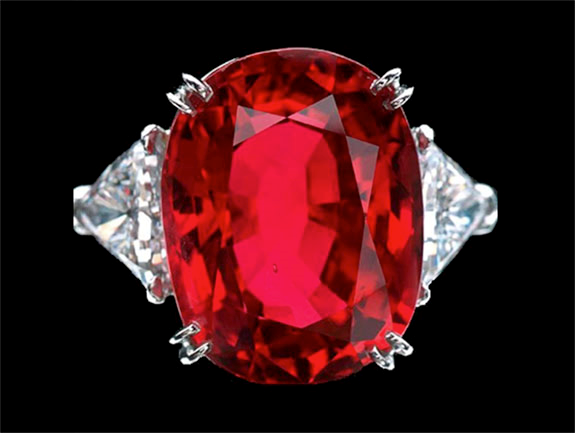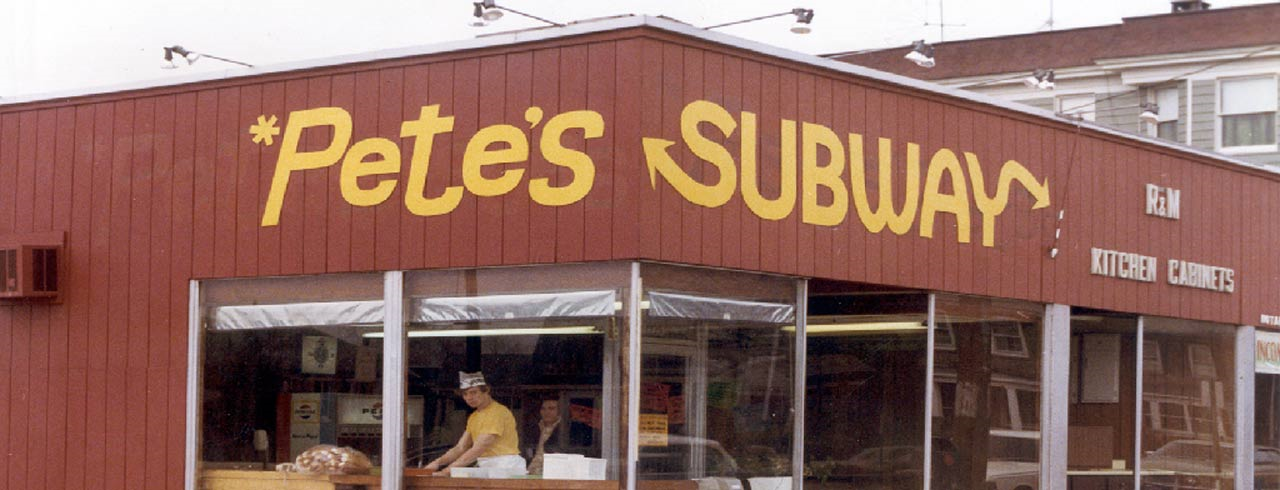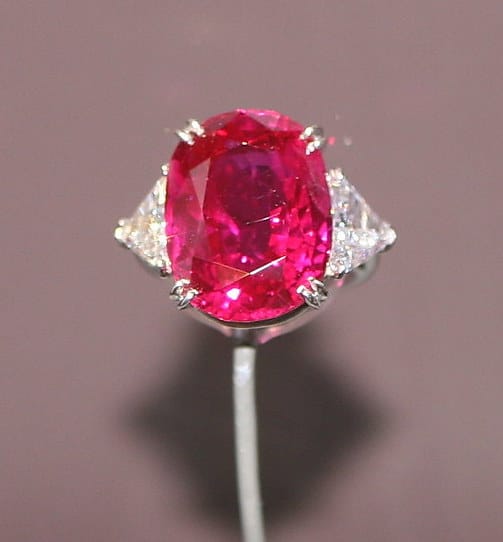The Love Story Embedded in the Carmen Lúcia Ruby
by Ken Rock, MSDC Editor

Judging by the crowds, one of the most popular gems on display at the Smithsonian's Geology, Gems, and Mineral Hall is the 23.1 carat Carmen Lúcia ruby that is the largest faceted ruby in the National Gem Collection and one of the finest large, faceted Burmese rubies known. Like many of the donated gemstones and jewelry on display, the story behind the donated gem has an interesting history that dates back almost 60 years, to 1965 when a 17-year-old college student named Fred DeLuca sought advice from family friend, Dr. Peter Buck, on how to pay his college tuition at the University of Bridgeport in Connecticut. Buck, who was then working for General Electric designing nuclear power plants, answered: open a sandwich shop.
As a volunteer in the Geology, Gems, and Mineral Hall of the Smithsonian’s National Museum of Natural History (NMNH), I meet people from all over the world who have come to see the amazing collection of gemstones, minerals, and meteorites and to learn about topics such as mining, minerals used in our daily lives, plate tectonics, and our solar system. Most visitors begin their tour with a stop at the Hope Diamond which is on display in a special case that rotates the necklace to all four sides for people to take photos and contemplate what may be the world’s most well-known diamond.
Equally impressive to me, however, is the strong interest people have in the adjacent gallery which displays many famous and historically significant gemstones and jewelry, many of which are donations.
The Carmen Lúcia ruby is featured in Dr. Jeff Post’s book Unearthed, Surprising Stories Behind the Jewels, published in 2023, that highlights some exceptional gems from the Smithsonian’s National Gem Collection. As Dr. Post notes in his comments:
“The ruby is exceptional because of its size, richly saturated homogeneous red color, and outstanding transparency. It was mined form the fables Mogok region of Burma in the 1930s… and is set into a platinum ring flanked by triangular-shaped diamonds.”
Pete’s Super Submarines
Little could Fred DeLuca or Peter Buck imagine that the partnership they established in 1965 would ultimately change the landscape of the fast-food industry. DeLuca honored his benefactor by naming the shop “Pete’s Super Submarines” with the priciest sandwich selling for 69 cents. They later formed Doctor's Associates Inc. to oversee operations of the restaurants as the franchise expanded. The holding company derived its name from DeLuca's goal to earn enough from the business to pay tuition for medical school, as well as Buck's having a doctorate in physics. In 1968, the sandwich shop was renamed Subway. Although Dr. Buck said that "We didn't make a profit for 15 years," their decision to turn their sandwich shop into a chain by franchising was a move that would eventually make both of them billionaires.

That single original store has since grown into the mammoth Subway chain, with 37,000 restaurants in more than 100 countries. Only McDonald's has more restaurants worldwide (about 40,000). The $1,000 investment by the late Dr. Peter Buck has got to be one of the most lucrative investments in U.S. history.

Peter Buck's a-ha moment for the sandwich business occurred, he said, when he was a boy in Portland, Maine. He worked as a laborer in the vegetable fields, making 20 cents an hour. On occasion, his family would dine on Italian sandwiches made at a place called Amato's. The long line out of the door and the diamond rings and gold bracelets of the women behind the counter "impressed a little boy," said Dr. Buck. Thus, it's not too surprising that jewels became one of many outlets for Dr. Buck's philanthropy, which leads us to the gemstone part of the story...

The Ruby Ring
Since 2004, visitors to the National Gem and Mineral Collection at the NMNH have marveled at the Carmen Lúcia Ruby. Prominently displayed in the showcase titled “Rubies and Sapphires,” the gem has the distinction of being the largest faceted ruby in the collection and one of the finest Burmese rubies ever known.
The Carmen Lúcia Ruby is named for Carmen Lúcia Buck, the beloved second wife of Dr. Buck, who provided the funds for the Smithsonian to purchase the stone after her passing in 2003. Born in Brazil, Carmen was a collector of jewels as well as a philanthropist dedicated to medical research, the elderly, and children in her home county. She had learned of the ruby from jeweler Frank Cappiello of Danbury, CN, who, in 2002, had heard that it might be coming on the market after many years in private hands.

Carmen had been undergoing treatments for colon cancer in 2002 and had seen photos of the magnificent ruby. She had hoped to purchase the ring to celebrate her recovery. Sadly, she would never wear it and, in fact, never got to see the actual stone.
Instead, in a great act of love and honor for the memory of his wife, Dr. Buck would gift the Carmen Lúcia Ruby to the American people with the assurance that it would go on permanent display.
“So it seemed like a really appropriate thing to do, to give it to the nation so people could come and see it,” he told The New York Times in 2004. “She would have really liked that people could see it and know it was the Carmen Lúcia Ruby, and that it wasn’t locked away in a vault somewhere.”
At the time, National Gem and Mineral Collection curator Jeffrey Post called the Carmen Lúcia Ruby "the most important addition to the collection in the 20 years that I’ve been here."
Sourced in the fabled Mogok region of Burma (now Myanmar) in the 1930s, the Carmen Lúcia Ruby displays a richly saturated red color with undertones of pink and purple, a coveted hue known to gem experts as "pigeon blood red." The 23.1 carat oval-cut stone is set in a platinum ring and flanked by two trillion-cut white diamonds weighing a combined 2.38 carats.

Peter Buck never disclosed how much he donated to the Smithsonian to purchase the ruby. We do know, however, that a similar stone — the 25.59-carat Sunrise Ruby — established a new world record for the highest price ever paid at auction for a ruby when it yielded $30.3 million at Sotheby’s Geneva in May of 2015.
But the true value of the ring, as is often the case with such items, its value, lies more in its meaning than in dollars. As an expression of the abiding love of a man for a woman, the Carmen Lucia ruby ring should sparkle for all who see it in the years ahead. Buck told Smithsonian magazine for the February 2005 issue that "Already, the ring has probably been seen by more people than had seen it altogether since it was first unearthed in the 1930s."
Provenance Largely Unknown
Regrettably, an online search does not provide results that identify who owned the Carmen Lúcia ruby before it was sold to the Smithsonian. However, as former curator Jeff Post has pointed out, "it's not so unusual to have remarkable stones remain for generations in private family vaults. When such a treasure surfaces," Post said, "it causes a major stir in the gem world."
Below are some highlights of what we do know about the provenance of the stone:
- The ruby was mined in the Mogok region of Burma (now Myanmar) in the 1930s.
- After being mined and cut, the ruby remained in private hands for many years before surfacing on the market around 15 years prior to its acquisition by the Smithsonian in 2004.
- International gem dealers bought the ruby around 15 years before 2004, but its provenance and ownership history before that is unclear. "We don't know who owned the stone before international gem dealers bought it 15 years ago."
So, in summary, while the specific previous owner(s) are not named, we do know that the Carmen Lucia ruby was privately owned, likely by a wealthy family, for decades after being mined in the 1930s until being sold to international gem dealers around 1989. Its ownership trail before then is unknown.
For Your Visit to the Geology, Gems, and Mineral Hall
The Carmen Lúcia Ruby can be seen near the Hope Diamond and Logan Sapphire at the Janet Annenberg Hooker Hall of Geology, Gems and Minerals in the Smithsonian's Natural History Museum. It’s not as big as the famed Hope Diamond or some other stones but it is about as big as rubies get, according to Dr. Post.
The bright light reflected from the faceted ruby and the adjacent natural ruby on matrix specimen easily draws attention away from the larger sapphire that is displayed nearby. The two types of stone are displayed together because they are essentially the same material – corundum, or aluminum oxide. The ruby gets its red color from traces of chromium, while other materials, such as iron and titanium, give the sapphire its usual blue color. Curiously, only a few hundredths of a percent of iron and titanium can cause the color, and the more iron the corundum contains, the darker the blue.
Dr. Post also noted that some large red gems are on display in various collections labeled rubies, but many of them are actually spinels, a different type of stone that is also red. While rubies are aluminum oxide, spinels are magnesium aluminum oxide. Spinels look like rubies and attracted much interest in the past because they tend to be larger, he said.
Sources
The Natural Ruby Company, Famous Rubies of the World
Carmen Lúcia Ruby - Smithsonian National Museum of Natural History
Billionaire a real gem as Smithsonian donor - The Columbus Dispatch
Owen Edwards, Smithsonian Magazine, Romance and the Stone. February 2005.
Jeffrey Edward Post, Unearthed, The Smithsonian National Gem Collection, Surprising Stories behind the Jewels, 2021.
The Jeweler Blog, 23-Carat Carmen Lúcia Ruby Is One of the World’s Most Extraordinary Examples of July’s Birthstone, July 10, 2017.
Melanie Grayce West, The Wall Street Journal, Subway Restaurant Founder Donates $30 Million to Support Danbury Hospital, June 19, 2014.
